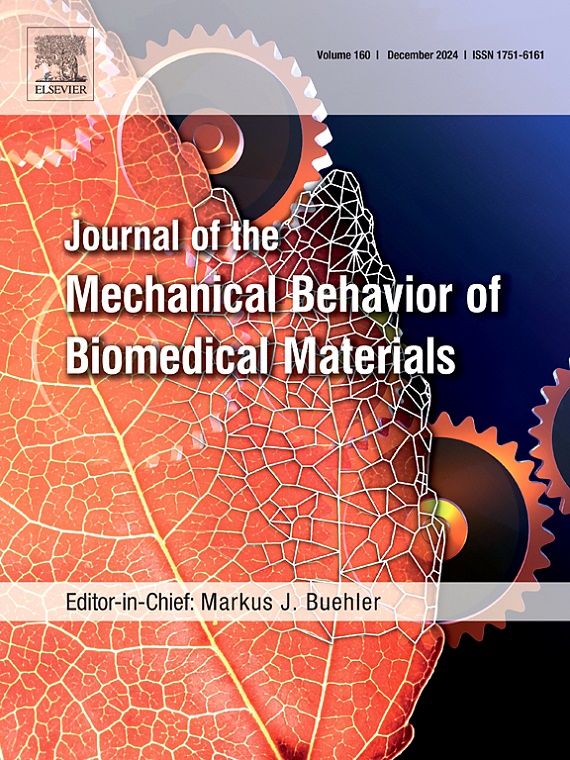轴突和矩阵的本构建模:一种有限元和神经网络方法
IF 3.5
2区 医学
Q2 ENGINEERING, BIOMEDICAL
Journal of the Mechanical Behavior of Biomedical Materials
Pub Date : 2025-06-07
DOI:10.1016/j.jmbbm.2025.107082
引用次数: 0
摘要
弥漫性轴突损伤是一种常见的脑白质轴突损伤。轴突的计算模型,无论是孤立的还是在基质内,已经发展到在细胞和组织水平上研究这种损伤。然而,轴突的行为在很大程度上取决于周围基质的力学性能。轴突和基质的准确材料特性对于其行为的真实建模至关重要。本研究表征了人类脑组织中两个不同白质区域的轴突及其基质的超粘弹性特性。首先,利用先前孤立轴突在张力作用下的实验数据来确定其力学性能。然后,采用有限元分析、神经网络和优化方法,利用大变形和变应变率下三种剪切模式下人脑组织行为的实验数据推断出基质的性质。结果表明,轴突的硬度大约是周围基质的10-13倍,这取决于区域。本研究中定义的材料特性提供了损伤条件下轴突和基体行为的准确表示,因为它们是基于大应变和高应变率的数据。本构模型可以在细胞水平上更精确地评估弥漫性轴突损伤阈值和损伤机制。本文章由计算机程序翻译,如有差异,请以英文原文为准。
Constitutive modelling of the axon and matrix: A finite element and neural network approach
Diffuse axon injury is a common trauma that affects the axons in the brain’s white matter. Computational models of axons, both in isolation and within the matrix, have been developed to study this injury at cellular and tissue levels. However, axonal behaviour depends strongly on the mechanical properties of the surrounding matrix. Accurate material properties of axons and the matrix are essential for realistic modelling of their behaviour. This study characterises the hyper-viscoelastic properties of axons and their matrix for human brain tissue in two different white matter regions. First, previous experimental data on isolated axons under tension were used to determine their mechanical properties. Then, employing finite element analysis, neural networks, and optimisation methods, matrix properties were inferred using experimental data on human brain tissue behaviour under three shear modes at large deformations and varying strain rates. The results indicate that axons are approximately 10–13 times stiffer than the surrounding matrix, depending on the region. The material properties defined in this study provide an accurate representation of axonal and matrix behaviour under injurious conditions, as they are based on large-strain and high-strain-rate data. The constitutive model can be used for a more precise assessment of the injury threshold and the mechanisms of diffuse axon injury at the cellular level.
求助全文
通过发布文献求助,成功后即可免费获取论文全文。
去求助
来源期刊

Journal of the Mechanical Behavior of Biomedical Materials
工程技术-材料科学:生物材料
CiteScore
7.20
自引率
7.70%
发文量
505
审稿时长
46 days
期刊介绍:
The Journal of the Mechanical Behavior of Biomedical Materials is concerned with the mechanical deformation, damage and failure under applied forces, of biological material (at the tissue, cellular and molecular levels) and of biomaterials, i.e. those materials which are designed to mimic or replace biological materials.
The primary focus of the journal is the synthesis of materials science, biology, and medical and dental science. Reports of fundamental scientific investigations are welcome, as are articles concerned with the practical application of materials in medical devices. Both experimental and theoretical work is of interest; theoretical papers will normally include comparison of predictions with experimental data, though we recognize that this may not always be appropriate. The journal also publishes technical notes concerned with emerging experimental or theoretical techniques, letters to the editor and, by invitation, review articles and papers describing existing techniques for the benefit of an interdisciplinary readership.
 求助内容:
求助内容: 应助结果提醒方式:
应助结果提醒方式:


